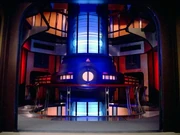
The warp core of a Galaxy class starship.
Warp drive is the primary propulsive force behind most advanced space vessels, propelling them faster than the speed of light. The drive does this by generating warp fields to form a subspace bubble that envelops the starship, distorting the local spacetime continuum immediately around the ship and moving the starship at superluminal velocities. These velocities are referred to as warp factors.
Technology
Warp drive works by distorting the fabric of space to propel the vessel. Simply put, the drive warps space, both in front of and behind a starship, allowing it travel faster than the speed of light. Specifically, spacetime is contracted in front of the ship and expanded behind it. The starship itself rests in a warp bubble between the two spacetime distortions. This warped space, together with the region inside it, accelerates off at "warp speed" and the vessel then essentially "surfs" the wave in spacetime created by this distortion.
Travel at velocities exceeding the speed of light is possible in this fashion because the starship is, strictly speaking, stationary (relative to the space inside the warp bubble) while spacetime itself is moving. Since spacetime itself is moving and the starship is not actually accelerating, it experiences no time dilation, allowing the passage of time inside the vessel to be the same as that outside the warp bubble.
Modern Federation warp engines are fuelled by the reaction of deuterium and antideuterium, mediated through an assembly of dilithium crystals, which are nonreactive with antimatter when subjected to high-frequency electromagnetic fields. This reaction produces a highly energetic plasma, called electro-plasma, which is channelled by magnetic conduits through the electro-plasma system (EPS). The warp plasma is funneled to plasma injectors into a series of field coils, usually located in remote warp nacelles, which generate the desired warp field. Other civilizations use different power sources, such as artificial quantum singularities, but the basic process is similar. (Star Trek: The Next Generation Technical Manual).
Starships can engage their warp drives while in the upper atmosphere of a planet, but the maneuver is very dangerous. To engage a warp drive in the lower atmosphere would be suicidal. When time traveling back to 1986, the HMS Bounty engaged the warp drive in Earth's upper atmosphere. (TOS novelization of Star Trek IV: The Voyage Home).
Development
Every culture in the galaxy discovered warp drive at their own pace and rate of development. The Vulcans (and, by extension, the Romulans) had warp drive in the 3rd century AD (Earth calendar) - although the technology was lost during that planet's civil war, and was not reacquired until several centuries later and had reached the level of warp 7 by 2151, whilst the Klingons had a capability of warp 6 by the same year, although it is unclear when their experiments with the drive began.
Humans had achieved warp drive for the first time in 2063. By the early 22nd century, they reached the level of warp 2, and by 2151 fielded the Enterprise (NX-01) - which had an engine capable of warp 5. Ten years later humans had engines capable of sustaining warp 7. It was the rapid progress of humanity which led to the wide-scale exploration of the galaxy and the formation of the United Federation of Planets.
The development of the warp drive is recognized by the United Federation of Planets as the marker of an advanced society. It is only after a people develop warp drive that the Federation will make contact, as codified in the Prime Directive. (Star Trek: Star Charts).
Future
Glimpses into alternate timelines and temporal anomalies have given Starfleet scientists the chance to see possible enhancements to the warp drive system. In a future glimpsed by Jean-Luc Picard, by 2395, the warp scale had been reworked again, allowing speeds of at least Warp 13 (at least on board the USS Pasteur). (TNG episode: "All Good Things...").
However, it seems more likely that warp drive will be surpassed by newer forms of propulsion, such as the quantum slipstream drive. (VOY episode: "Hope and Fear").
See also
Connections
- Warp drive article at Memory Alpha, the wiki for canon Star Trek.
![]() Translation articles from wIqImu'ghom: warp drive (Federation Standard) - pIvghor (tlhIngan Hol)
Translation articles from wIqImu'ghom: warp drive (Federation Standard) - pIvghor (tlhIngan Hol)
